When the original G.I. JOE action figures were first produced in 1964, they were 12 inches tall and extremely popular. However, the Vietnam War made military toys unpopular and the series turned to adventure themes before finally ending in 1976. However, the G.I. JOE many today are more familiar with featured 3/75 inch figures and was introduced in 1982 as the military and American pride regained popularity. This new line of toys featured dozens of different characters as well as vehicles and playsets. A television series and comic book series also added to the popularity. While I was a bit older than the target audience when the new toys were released, my younger brother collected many of the figures and vehicles and I will admit I also had some of my own which I displayed on my desk. I also enjoyed watching the cartoons and playing with my brother’s collection. Many of my generation have fond memories of G.I. JOE. Now we, as well as those older and younger, can continue the fight against Cobra with the G.I. JOE Deck-Building Game.
What Is the G.I. JOE Deck-Building Game?
G.I. JOE Deck-Building Game is a cooperative deck-building card game for 1-4 players, ages 14 and up, and takes about 30-70 minutes to play. Players recruit classic Joes and vehicles and send them on dangerous missions to defeat Cobra and their plans for global domination. It’s currently available at your FLGS as well as from the Renegade Games Studio store on Amazon and sells for a suggested retail price of $45 for a copy of the game. There are also two expansions currently available: Shadow of the Serpent and Cold Snap. They sell for $30 each. G.I. JOE Deck-Building Game was designed by T.C. Petty III and Matt Hyra, published by Renegade Game Studios, with illustrations by Robert Q. Atkins.
G.I. JOE Deck-Building Game Components
Here is what you get in the box:
- 117 Player cards
- 24 Cobra cards
- 24 Complication cards
- 36 Mission cards
- 1 Threat meter
- 4 threat markers
- Mission Success and Failure tokens
- 1 Reserve Tile
- 1 Hangar tile
- 1 End of Round token
- 8 Dice
- 4 Player Aid cards
- 6 Expert Mode cards
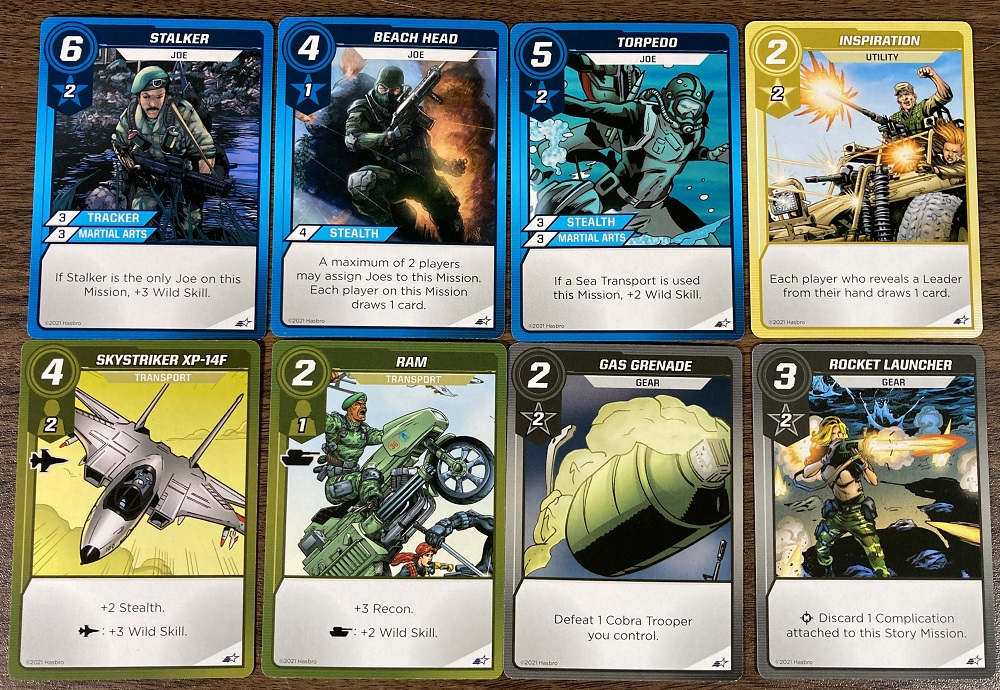
The player cards represent individual Joes, vehicles, gear, weapons, tactics, and fighting spirit. The name of the card is printed across the top. The large number in the upper left corner is the cost to recruit that card. The number in the star below is the value of the card for recruiting other cars. Joe cards have one or more skills listed in the middle of the card along with their skill value. Some cards also have ability text at the bottom. Transport cards have a capacity value rather than a recruit value as well as a transport type symbol. These represent how many Joes the vehicle can carry and if the type of transport matches the mission, then some abilities can also be used.
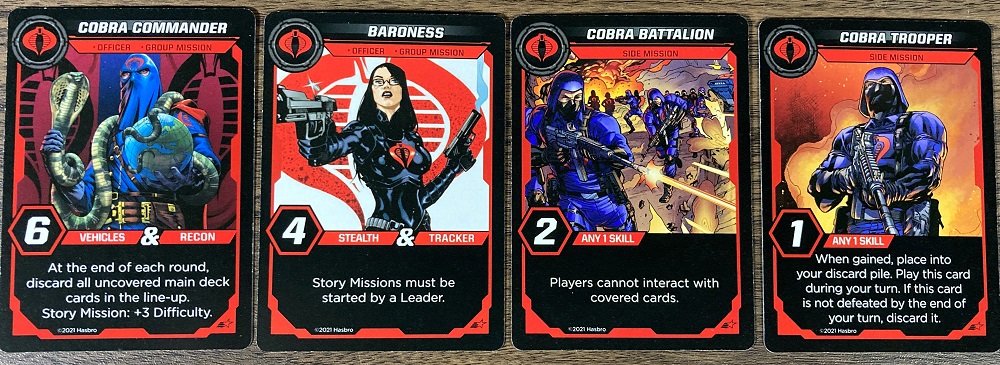
Cobra cards can have Cobra Officers on them or Cobra Troopers or Cobra Battalions. They all have a difficulty value and one or more skills listed on them. These cards also have ability text that describes how they function in the game.

Complication cards are brought into play by Story Mission cards as well as through other means and make the lives of the Joes more difficult. Some affect the current Story Mission while others, such as Precision Strikes, are played against individual players. Some have an instant effect while others are missions that must be defeated themselves.

The Story Mission cards must be defeated by the players in order to win the game. The game comes with two different storylines, each made up of 18 different Mission cards divided into three Acts. During a game you only use 9 of the 18 mission cards. The three finale Mission cards are always the same for a specific story, but the other six cards are randomly chosen at the start of a game so that you get different combination of missions each time.

The Threat Meter keeps track of the threat level during the game. If the Threat Marker ever gets to the Cobra space, the players lose the game. Other tokens are used to keep track of mission successes and failures as well as other functions.

The game includes eight custom dice. Three of the sides have an O for no hits, two sides with a 1 Hit symbol, and one side with 2 Hit symbols. The dice are rolled to determine the success of a mission.
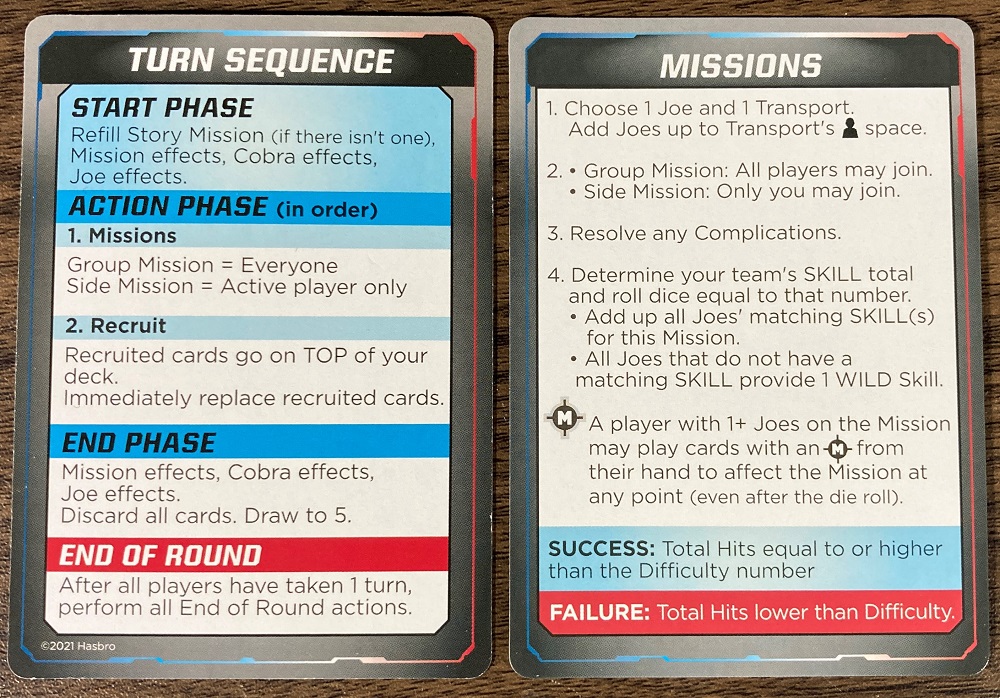
Each player gets a Player Aid card which s reminds them of the turn sequence of the game as well as the steps for a mission. These are great when learning the game and to ensure you don’t skip a step.
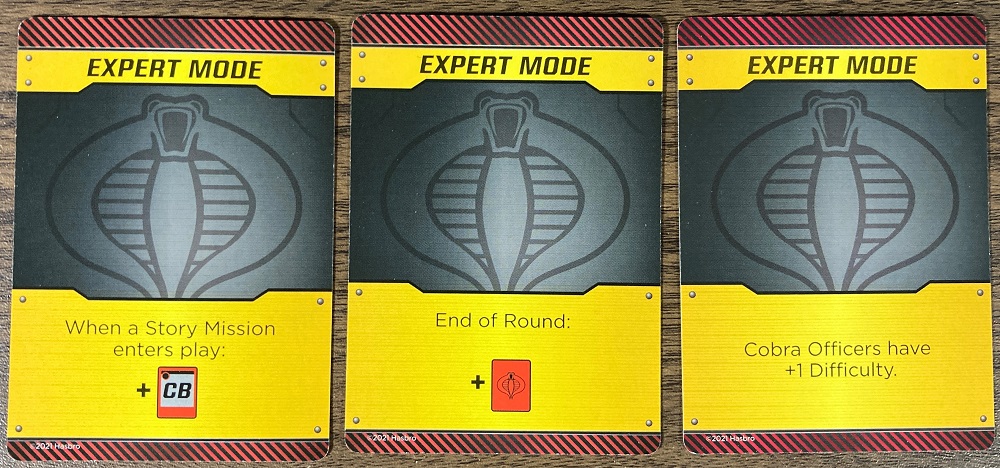
Once you have won a few games, add one or more Expert Mode cards to make the game more challenging. Each contains text that remains active for the entire game.
How to Play the G.I. JOE Deck-Building Game
You can download a copy of the rulebook here.
The Goal
The goal of the game is to defeat the final Story Mission.
Setup
Start off the setup process by shuffling the six starter leader cards and randomly giving one to each player. Return the remainder to the box. each player also gets the promoted card for their leader and placed it aside to use later. Give each player a starter deck of 9 cards to add to their leader. Players shuffle their decks and then draw five cards to form their hand. Place the Hangar token in reach of all the players and put the VAMP starter transport card on it. Take the remaining player cards and shuffle them into a deck. Deal out six cards and place them in a line in the center of the play area. Place the deck face down to the right of the line of cards and place a stack of Service Rifle cards to the left of the line. Select a starting player and place the End of Round token to the right of them.
Now it is time to setup Cobra. Turn the Threat Meter to the side that lists the number of players and place the Threat Marker on the starting space on the bottom of the meter. Divide the Complication cards into stacks based on their Act number. Shuffle the Act 1 cards into a pile and place them face down in a stack. Set aside the cards from the other two acts for now. You will add them later. Place the Success and Failure tokens near the Threat Tracker. Then place stacks of Cobra Troopers, Cobra Battalions, and Cobra Officers in separate piles face up. Finally, choose which of the two stories you would like to play and assemble the Story Mission deck. You are now ready to play.

Gameplay
The G.I. JOE Deck-Building Game is played in multiple rounds in which each player takes a turn. Since players are working together to defeat Cobra, they are allowed to communicate with one another all throughout the game. Each player, beginning with the starting player, completes their turn and then the next player to the left goes. Before the starting player takes their next turn, complete the end of round steps and then continue playing. Each player’s turn is divided into three main phases: Start, Action, and End. During the first round, each player only recruits and completes the End phase.
Start Phase
During this phase, you complete two steps. First players check to see if there is a Story Mission in play. If there is, skip this step. Otherwise, take the top card from the Story Mission stack and put it into play above the line of Player cards. If the Mission card has the complication symbol with a number on it, then draw that many Complication cards and set them face down near the Story Mission card. The next step is to resolve any start of turn effects which may be listed on cards.
Action Phase
The Action Phase is divided into two steps. Players first can undertake missions and then they can recruit. There are two types of missions: Group Missions which include Story Missions and Cobra Officers, and Side Missions which consist of Cobra Troopers, Cobra Battalions, and Precision Strikes. Other players can help out with Group Missions while only the active player can complete Side Missions. A mission has three main steps. First the active player selects a mission and choose one Joe and one Transport to go on the mission. Additional Joes can be added up to the Transport’s capacity. For Group Missions, other players can add their Joes so long as they can fit in the Transport. Try to select Joes with the skills required by the mission to increase your chance of success. Wild skills can be used for requirement. Now reveal and resolve any Complications that are assigned to the mission. Players can use effects they might have that target Complications before you resolve them. Finally, determine your team’s final skill level by adding the skill values of each Joe that match the skill requirements of the mission. Joes that don’t have a matching skill can still contribute 1 Wild skill. The total skill level is how many dice you get to roll. After rolling them, count up the number of hits. Some cards have a target symbol that means they can be used during a mission. Before resolving the die roll, you may want to play these cards or abilities in case you need to reroll some dice. After all this is done, compare the total number of hits on the dice to the difficulty number on the mission. If the hits match or exceed the number, the mission is a success. If the hits are lower, then the mission is a failure. For a success of a story mission, gain the bonus and place the story card under the blue Success token. If you defeat a Cobra officer, return it to the supply. When a Story mission is failed, suffer the penalty for failure and then place the card under the Failure token. Failed Cobra officer missions leave the card in play.
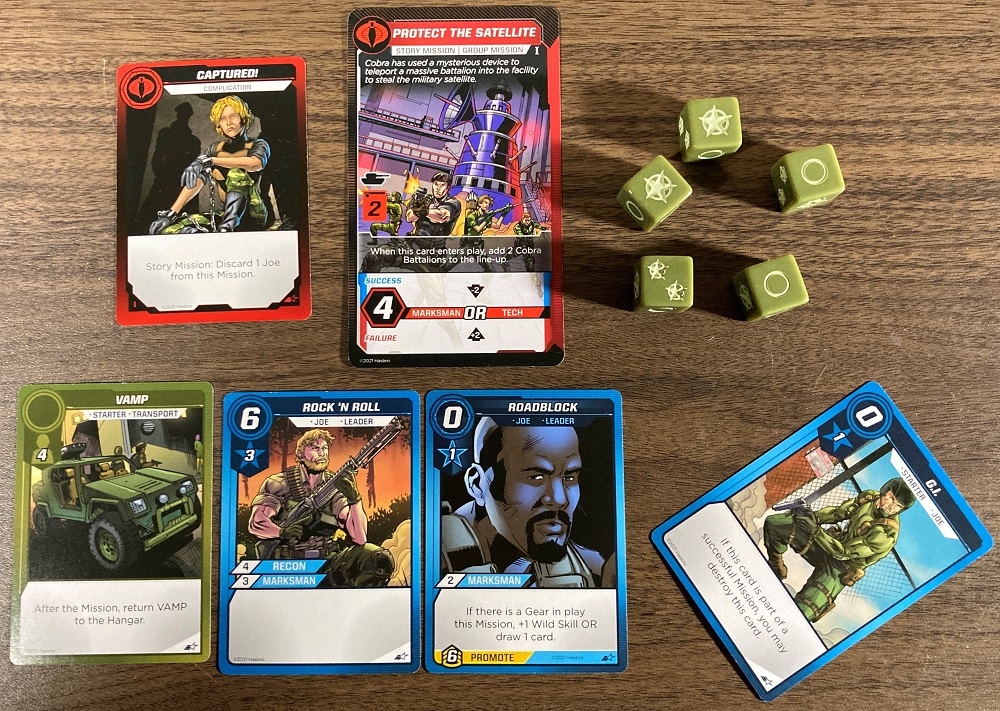
After a mission is completed, the active player sets their Joes played aside. Other players that contributed cards to the mission place them in their discard piles. The VAMP transport is returned to the hangar. Any other transport is placed in the active player’s discard pile. If the active player has Joes remaining in their hand, they may choose to start another mission. Side missions follow similar steps except that only the active player may use their Joes and cards. Other players may not contribute.
Once the active player has undertaken all missions they desire, they then can recruit new cards. Total up the recruit value of all their cards played as well as in their hand. They can then use this amount to recruit one or more cards from the line. As soon as you recruit a card, immediately replace it with a card from the deck. All recruited cards are placed face down on top of the player’s deck, so they will get them for their next turn. If a player’s leader is in play, they may spend 6 recruit points to promote their leader. Return your starter leader card to the box and place the promoted leader card on top of your deck. Any unused recruit points are lost and do not carry over to the next turn.
End Phase
There are two steps to this phase. First resolve all end of turn effects that might be on the Story Mission card, Cobra cards, and the Threat Meter. Finally, discard your hand and all of the cards you played and draw five cards to form your new hand. The next player now begins their turn.
End of Round
When the end of the round is reached, first resolve any end of round effects found on cards or the Threat Meter. Then move the Threat Marker up one space on the Threat Meter. Note that while the marker is in the green area of the meter, you will actually move the marker twice each round (once for the effect on the meter and again for the required move).
End of Act
When the Finale Story Mission of an Act is completed, a new Act begins at the start of the next player’s turn. After you place the new Story Mission card, take the Complication cards in the pile and in the discard and shuffle them together with the Complication cards for the new Act to create an upgraded Complication deck.
Game End
The game ends in victory once the players defeat the final Story Mission. However they lose if any of the following occur: the Threat Marker reaches the top space of the Threat Meter, Cobra Battalions cover five cards in the line-up and you have to add a sixth, or if the main deck runs out of player cards.
Why You Should Play the G.I. JOE Deck-Building Game
As I mentioned earlier, I am a fan of G.I. JOE, so I was interested in playing the G.I. JOE Deck-Building Game. Plus, deck-building is one of my favorite game mechanics. I did go into this with some apprehension. I have been burned by games that take an intellectual property and just use it as an overlay for a poor game. I am happy to say, that is not the case with G.I. JOE Deck-Building Game. I feel that the theme and the gameplay go hand-in-hand and work well together. I like the story aspect of the game. While you have to complete a total of nine Story Mission cards, the randomness of the missions adds to the replayability. Plus when you add in the Complication and Cobra cards, you actually have to defeat many more missions along the way. In fact since you don’t reveal Complications until after you have already assembled your team and send them on their way, those Complications can really mess up your plans, thus keeping players on their toes and ready to use additional cards in their hands that can be played during a mission.

I like how the game can be played solo. There are many times I want to just play a game and don’t have someone to play against. This game works great solo. Since you don’t have other players who can contribute to the group missions, the game lets you place one of the cards from your hand into Reserve. You can’t use it for a mission or to recruit. However, after you discard your cards at the end of the turn and draw new cards, you also get to add this reserved card so you now have six cards in your hand. This lets you prepare for the next turn. Also, you shuffle the promoted leader cards, other than your leader’s, into the deck so they can be recruited like other cards. Finally, in solo play, you play two turns before ending the round. I enjoy playing solo just as much as with other players. As a result, I get to play this game more often.
I also had a chance to review the first expansion to the game, Shadow of the Serpent. This expansion requires the core game and adds 20 player cards, 2 new leaders, 13 Cobra cards, 8 Complication cards, one Expert Mode card, and two new stories contained within 36 new Mission cards. Plus the expansion adds 5 Command Center tiles that let players build the G.I. JOE base. Each tile once built provides additional abilities the players can use. This expansion really adds to the game and I look forward to the Cold Snap expansion which adds two more stories, two more leaders, towable weapons, snow terrain and vehicles, and the Dreadnoks!

The G.I. JOE Deck-Building Game does a great job of making players feel like they are playing as a leader of the Joes. You recruit Joes and items, choose a mission, and then select a team to tackle that mission complete with a transport to get them there. Just as in the comics, Cobra always seems to have a surprise which the Joes have to overcome. That is what I was hoping for in this game and I am not disappointed. While I have talked about the gameplay, I also want to mention the look of the game. Each of the player, Story Mission, and Cobra Leader cards have unique artwork. All of it looks like the style found in the comics or the cartoons. In fact, I enjoy just browsing through the cards to admire the art. If you are a fan of G.I. JOE and/or like deck-building games, then I recommend the G.I. JOE Deck-Building Game as a fun addition to your collection, even if you will only be playing it by yourself. It also makes a great gift for G.I. JOE fans.
For more information or to make a pledge, visit the G.I. JOE Deck-Building Game page!
Click here to see all our tabletop game reviews.
![]() To subscribe to GeekDad’s tabletop gaming coverage, please copy this link and add it to your RSS reader.
To subscribe to GeekDad’s tabletop gaming coverage, please copy this link and add it to your RSS reader.
Disclosure: GeekDad received a copy of this game for review purposes.





